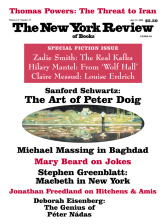In response to:
The Library in the New Age from the June 12, 2008 issue
To the Editors:
I read Robert Darnton’s essay on the library of the future [NYR, June 12] just as I was writing about a related issue: the copyright issues for Google Books are compounded in works for younger readers because the books have illustrations. That presents two problems for the digital library—any scholar who wants to study picture books will have to wait until Google strikes deals with illustrators. What is the point in examining, say, Goodnight Moon or Where the Wild Things Are without any sense of the interplay of text, design, and image that is the essence of the picture books? And, if anything, the problem is worse for photo-illustrated nonfiction—because there authors have only purchased the right to use the images in single print editions. The entire value of a book for younger readers—the care spent in designing pages, selecting images, and matching them to text—is lost if every illustration is merely a page with a caption and a note that the image is not available. While books for younger readers are the most obvious case, illustration and design are increasingly important in books for all ages. Unless and until some deal can be worked out for digital rights to images, the focus of the digital library is limited to text—just as we enter the golden age of visual narration.
Marc Aronson
Maplewood, New Jersey
Robert Darnton replies:
I certainly agree that the loss of illustrations would rob children’s books of their most vital quality. Moreover, the argument applies to books of all kinds and to all kinds of artwork—maps, graphs, and any graphic material covered by a separate copyright. Instead of merely illustrating an argument in a book, the artwork is often part of the argument—the most important part in many cases, as William Ivins (Prints and Visual Communication) and Edward Tufte (The Visual Display of Quantitative Information) have demonstrated. In works of fiction, text and page design may be so integrated as to be inseparable. When Google digitized Tristram Shandy, it mauled the text by eliminating pages that Laurence Sterne intentionally left blank, colored black, and marbled. If it reduces its rate of error to 0.5 percent, Google still will spoil one or two pages of a typical book.
I did not intend to contest the value of Google Book Search but merely to point out that digitized books have a long way to go before they can match the quality of a printed text. There is no denying that digitization can do wonders. It has revealed aspects of Beowulf, including lost vocabulary, which escaped observation by the naked eye. The most obvious advantage of digitization is its ability to make large numbers of books available and searchable. In trying to illustrate that point, I cited the example of the Electronic Enlightenment, a project I initiated at the Voltaire Foundation in Oxford many years ago. The idea was to create a database from the published correspondence of four eighteenth-century philosophers and statesmen, Voltaire, Rousseau, Franklin, and Jefferson. They wrote so many letters to so many people that a digitized record of all their exchanges would make it possible to trace references through an enormous, transatlantic epistolary network and to show how the Republic of Letters actually functioned as a communication system.
Unfortunately, however, the publishers could not reach an agreement that would include all four correspondences, which come to nearly two hundred volumes in print. Contrary to what I wrote, therefore, the digitization is now being restricted to the letters of European philosophers. I hope that enlightened self-interest will eventually prevail among the publishers and that the Electronic Enlightenment will include the American wing of the Republic of Letters.
This Issue
July 17, 2008
His Royal Shyness: King Hussein and Israel



